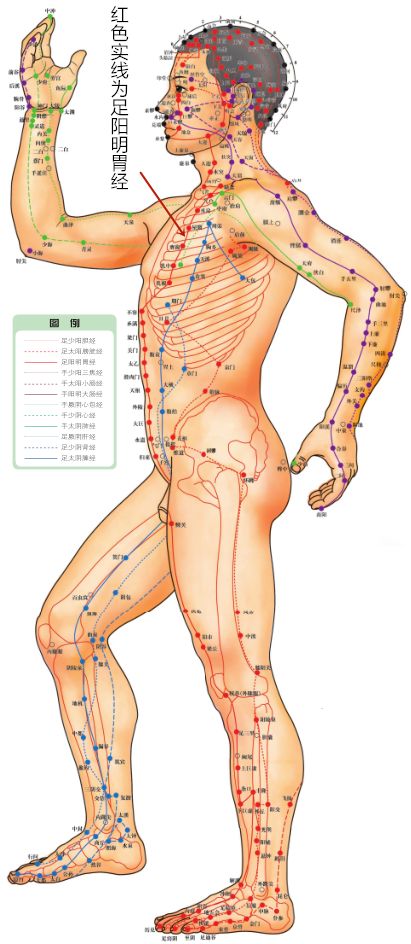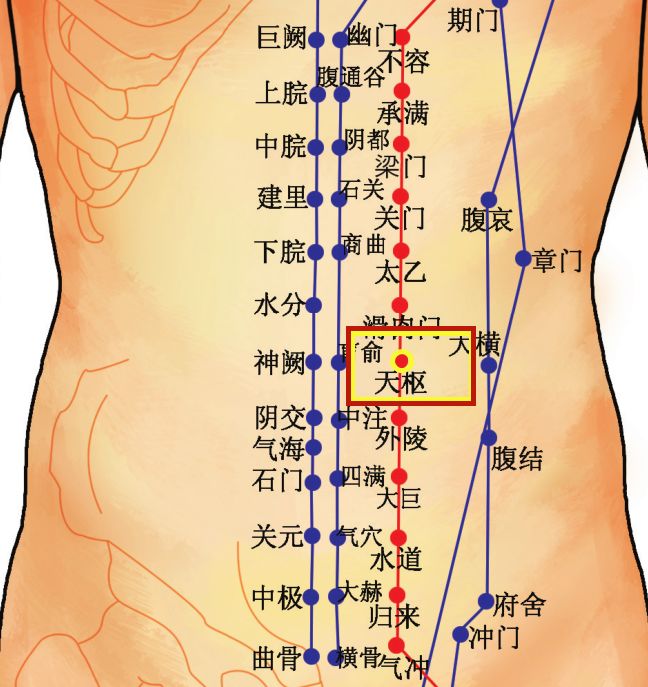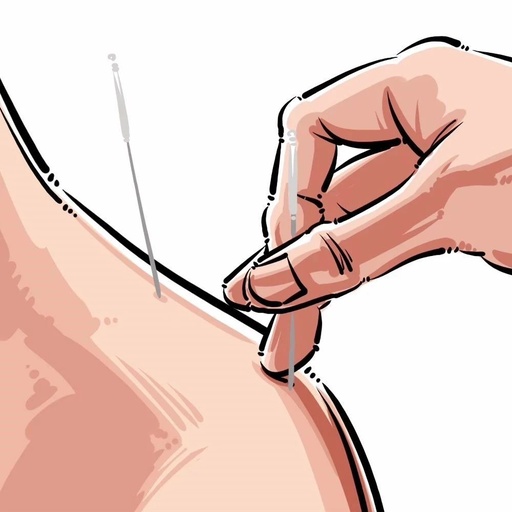Warm Reminder
This section aims to introduce the basic knowledge of acupoints in the human body, providing a fundamental understanding of them and a simple overview of their application in external therapies such as moxibustion, cupping, and guasha. Many acupoints have high risks associated with needling; therefore, non-professionals should not attempt needling operations!
The Stomach Meridian of the Twelve Meridians
🔹 Meridian Pathway
This meridian starts at the side of the nostril (Ying Xiang point), ascends along the nose, intersects at the root of the nose, enters the inner canthus of the eye, intersects with the Foot Taiyang Meridian, descends along the lateral side of the nose, enters the upper teeth, exits, runs alongside the mouth, encircles the lips, intersects at the Cheng Jiang point in the mentolabial groove, returns along the lower jaw bone to the Da Ying point, ascends along the angle of the jaw, passes in front of the ear, goes through the Shang Guan point (Ke Zhu Ren), along the hairline, and reaches the forehead.
This meridian has a branch that descends from the Da Ying point to the Ren Ying point, travels down the throat to the Da Zhui, bends forward, enters the Jue Pen, descends through the diaphragm, belongs to the stomach, and connects to the spleen. A direct branch descends from the Jue Pen to the surface, along the midline of the breast, running two inches on either side of the navel, and descends to the Qijie point outside the groin. Another branch emerges from the pylorus of the stomach, descends within the abdominal cavity to the Qijie point, and then descends along the front of the thigh to the knee, following the anterior edge of the tibia down to the dorsum of the foot, entering the lateral side of the second toe (Li Dui point). Another branch emerges from three inches below the knee (Zu San Li point) and descends to the lateral side of the middle toe. Yet another branch emerges from the foot’s dorsum at the Chong Yang point, moving forward to the medial side of the big toe (Yin Bai point), intersecting with the Foot Taiyin Spleen Meridian.

🔹 Summary of Indications
This meridian’s acupoints are indicated for intestinal sounds, abdominal distension, abdominal pain, stomach pain, ascites, vomiting, or excessive hunger, thirst, sore throat, epistaxis, pain in the chest and knee areas along the meridian pathway, febrile diseases, and mania.
Acupoint of the Stomach Meridian
🔹 Tian Shu
[Source] “Ling Shu: Meridians”, “Zhen Jiu Da Cheng”
[Location] On the abdomen, horizontally aligned with the navel, 2 inches lateral to the anterior midline.
[Needling Method] The patient lies supine; the Tian Shu point is located in the middle abdomen, level with the navel, 2 inches away from the navel (three finger widths to the left and right of the navel).

[Indications]
-
Abdominal pain, abdominal distension, constipation, diarrhea, dysentery, and other gastrointestinal diseases;
-
Menstrual irregularities, dysmenorrhea, and other gynecological disorders.
[Application]
Tian Shu is named after the Tian Shu star, which is the first star of the Big Dipper. Its left line connects to the second star of the Big Dipper (Tian Xuan), and its right line connects to the fourth star (Tian Quan). The name of this point implies that the qi and blood flow from this point has two pathways: one is the qi and blood exiting to the large intestine meridian at the Tian level, and the other is the qi and blood circulating through the stomach meridian. The qi and blood material of this point comes from two aspects: one is the residual qi of wind transmitted from the Tai Yi point and the Hua Rou Men point, and the other is the dampness qi transmitted from the Qi Chong point and Wai Ling point. After the qi and blood from the upper and lower parts of the stomach meridian converge at this point, due to the fullness of qi and blood, there is no other outlet except for the large intestine meridian, which is at a similar level to the stomach meridian, thus transporting to a higher Tian level.
The Tian Shu point regulates the middle and harmonizes the stomach, regulates qi and strengthens the spleen, smooths the intestines, resolves stagnation, and harmonizes the blood and regulates menstruation.The Foot Yangming Meridian belongs to the stomach and connects to the spleen; the stomach is the leader of the six fu organs. According to the “Huang Di Nei Jing Ling Shu: Ben Shu”: “The large intestine and small intestine both belong to the stomach.” This point is close to the stomach and intestines, being the mu point of the large intestine, where the qi of the large intestine meridian converges, thus it can regulate the stomach and intestines and is effective in treating large intestine disorders.
The Tian Shu point is indicated for abdominal pain, distension, intestinal sounds, diarrhea, dysentery, constipation, intestinal abscess, febrile diseases, hernia, edema, periumbilical pain, red and white dysentery, bacterial dysentery, vomiting, poor appetite, abdominal masses, malaria with chills, severe heat with mania, intestinal ascariasis, intestinal obstruction, appendicitis, simple digestive disorders in children, acute gastroenteritis, persistent diarrhea in children, turbid urination, umbilical hernia, jaundice, low back pain, cholecystitis, hepatitis, menstrual irregularities, endometritis, functional uterine bleeding, dysmenorrhea, amenorrhea, red and white leukorrhea, metrorrhagia, leukorrhea, postpartum abdominal pain, nephritis, etc.
The Tian Shu point combined with the Zu San Li point treats abdominal distension and intestinal sounds; the Tian Shu point combined with the Qi Hai point treats periumbilical pain;the Tian Shu point combined with the Shang Ju Xu point and the Xia Ju Xu point treats constipation and diarrhea.The Tian Shu point combined with the Zu San Li point has the effect of harmonizing the middle and stopping diarrhea, indicated for children’s diarrhea.The Tian Shu point combined with the Zu San Li point and the Nei Guan point treats digestive disorders and diarrhea.The Tian Shu point combined with the Shang Ju Xu point has the effect of detoxifying, clearing heat, and resolving dampness, indicated for acute bacterial dysentery.The Tian Shu point combined with the Shang Ju Xu point and the Qu Chi point treats bacterial dysentery.The Tian Shu point combined with the Shang Ju Xu point and the Appendicitis point has the effect of regulating qi, activating blood, and resolving stasis, indicated for acute appendicitis.
The Tian Shu point is a hub for adjusting the qi mechanism of the upper and lower abdomen, serving as a portal for the digestion and absorption of food essence. Regular moxibustion on the Tian Shu point has the effect of harmonizing the middle and strengthening the stomach.
Moxibustion Therapy: Use a moxa stick to perform circular moxibustion on the Tian Shu point for 10 minutes once a day, which can treat abdominal pain, distension, etc. (“Qian Jin”:Pregnant women should notperform moxibustion).
Effects of moxibustion on Tian Shu: Preventing and treating constipation, as the Tian Shu point is located on either side of the navel, an important point on the stomach meridian, its position corresponds to the intestines. Moxibustion at this point can promote healthy intestinal peristalsis, thus preventing and treating constipation. Treating large intestine disorders, the Tian Shu point belongs to the Foot Yangming Stomach Meridian and is also the mu point of the Hand Yangming Large Intestine Meridian. When the large intestine function is impaired, the Tian Shu point may be painful; moxibustion stimulation at this point can improve intestinal function and treat large intestine disorders.
Massage Therapy: Lying supine, use the index and middle fingers to knead the Tian Shu point for 2 minutes, which can relieve indigestion, nausea, vomiting, abdominal distension, diarrhea, and abdominal pain, with significant effects.
Cupping Therapy: Use a cupping jar to cup the Tian Shu point, leaving it for 10 minutes, every other day, which can treat diarrhea, dysentery, and other conditions.
Gua Sha Therapy: Use the scraping method, tilting the edge of the gua sha board in the direction of scraping, scrape the Tian Shu point until petechiae appear, every other day, which can treat intestinal sounds, diarrhea, and other conditions.
[Literature]
“Qian Jin Fang”: “If urination is not smooth… moxibustion on Tian Shu a hundred times. Tian Shu is indicated for malaria with chills, severe heat with mania. Tian Shu is indicated for winter months when there is a heavy cold leading to diarrhea, with pain around the navel, and cutting pain in the intestines and stomach.”
“Zhen Jiu Da Cheng”: “For women with symptoms of masses, blood clots, and irregular menstruation, with red and white discharge.”
*Acupoint images are from the illustrated “Huang Di Nei Jing” published by Zi Tu Books
Cover | Eight Years Old
Editor | Yuan Li Xue

